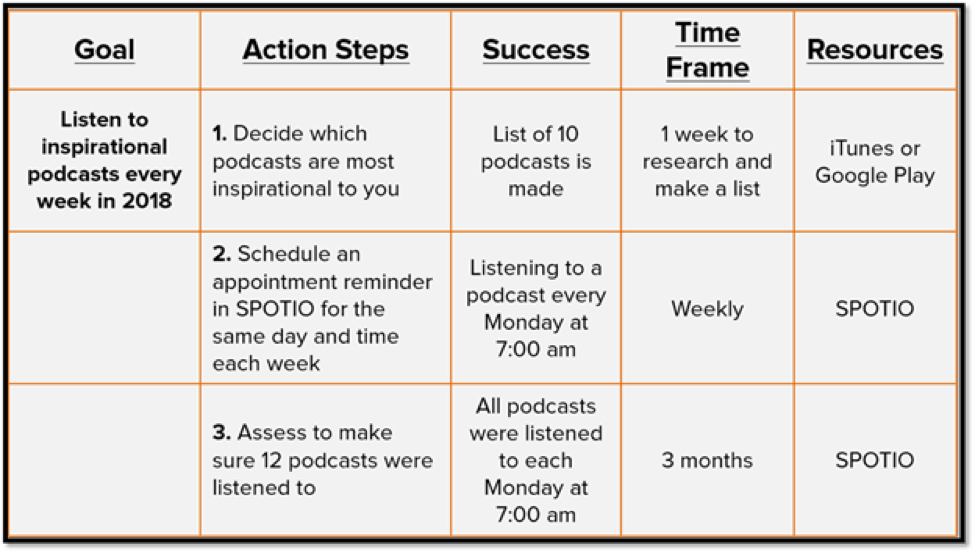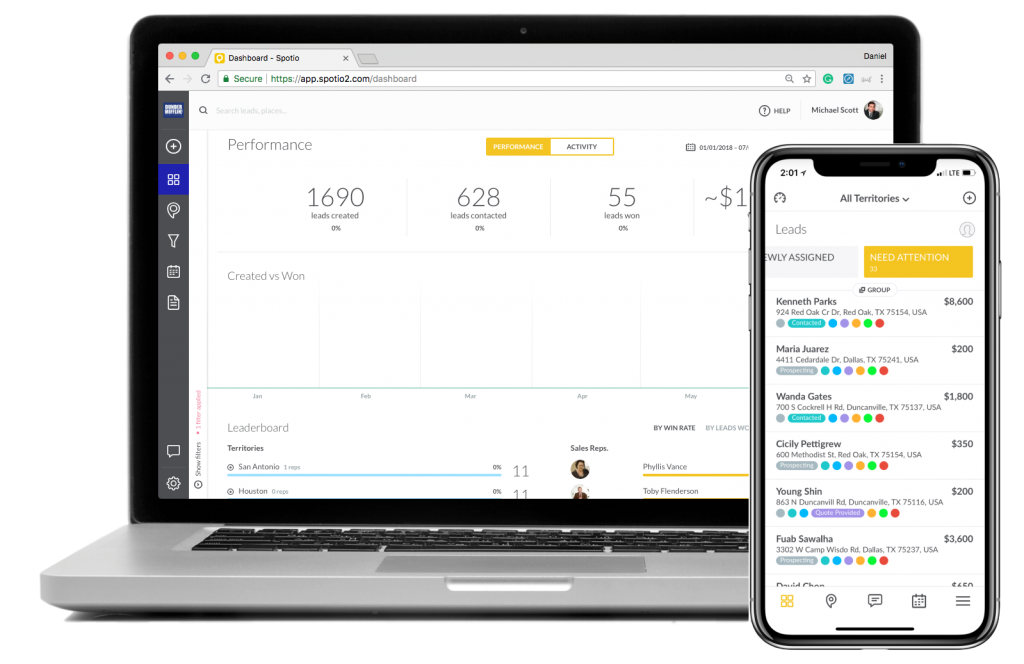Setting a standard across the sales team is imperative, and this is done by establishing goals via sales quotas.
Quotas allow managers and reps to know what it takes to be successful. But there’s an art to setting proper sales quotas. If they’re too hard or easy to achieve, it’ll kill motivation. Reps either give up due to feeling defeated, or they’ll take their foot off that gas and glide into their sales quota with minimal effort.
Done properly, reps will know what it takes to thrive and stay motivated until they achieve the (realistic) goals set forth.
Why Goals Are The Backbone of Sales Success
- Holds everyone accountable
- Drives motivation
- Boosts sales
- Clear and concise way to measure success
Type “goal setting” into Google and hit enter. (Go ahead and try it… Seriously.)
My 0.61 second search yielded over 49 million results! You can easily become overwhelmed with the ungodly number of articles promising the most effective method of setting goals.
With everyone searching for the “secret formula,” you’d think it would be out there, but the problem is most are searching for the wrong thing.
It’s not the goal setting aspect that matters.
The ‘Earth-Shattering’ Reveal
“To make something of yourself you must have goals,” said in that preachy father-like voice. We’ve heard it over and over from parents, teachers, media, motivational speakers, coaches, our favorite movies, and the list goes on. We’re bombarded with it until it’s become part of our being, so much so that millions of articles have been written about it, over 49 million to be exact.
We know how to set goals but often fail to recognize and understand how to actually achieve the goals we create for ourselves. Enter S.M.A.R.T. Goals – the best method to not only set goals, but make sure there’s a plan in place to reach our desired result.
Big Goals Invite Big Obstacles
It’s no secret that accountability produces results. Whether you’re a manager setting the quota for your team or a sales rep who won’t stop working 15 hours a day to get that beautiful new BMW that’s been on your mind, holding yourself accountable is the driving force that allows you to reach beyond your current disposition and realize your maximum potential.
To say that you’re going to encounter a few bumps in the road along the way is an understatement. Whether you’re setting sales goals or personal goals, the path to success is not void of obstacles.
The people who push on and persevere when everyone else so eagerly gives up are the people with the biggest goals. When you have small goals, every challenge proves more difficult and every obstacle seems larger.
Types of Sales Goals
Activity Goals
Or better known as, “sales activities”, are goals that measure activities of each rep. Activity goals are 100% controlled by the rep. It’s up to the individual to hit these metrics; which is can usually accomplished through effort and focus. Achieving activity goals sets them on track to hit their daily, weekly, monthly, and annual goal.
Examples of activity goals: doors knocked in a day, appointments set per week, proposals sent, etc.
Annual Goals
Your annual goal is the driver of all your goals. Hitting these targets is – ultimately – the most important. However, this is a number, target, metric, and/or measurement that management/executives focus on; it’s too overarching for reps to concern themselves with.
An example of an annual goal would be: Increase new accounts by 15%.
Team Goals
Team goals are usually measured on a monthly or quarterly basis and requires each team member to contribute a certain percentage in order for the team to be successful.
The real purpose behind a team goal (because individual goals suffice to reaching the annual goal just as well) is to provide unity amongst the team. When everyone works together to share in a common goal, it build camaraderie and drives a motivated sales culture.
An example: sell a combined total of at least $225,000 in MRR this quarter.
S.M.A.R.T. Goals Stands For:
Specific clear and unambiguous telling exactly what is expected
Measurable concrete criteria for measuring progress toward goal attainment
Attainable challenging and high reaching but ultimately can be achieved
Relevant is in alignment with the individual, team and goal
Time Related a committed deadline
SMART Goals Examples
SPECIFIC: More than just setting a goal to increase door knocks, a SMART goal would be to increase door knocks by 10 per day.
MEASURABLE: Have a concrete number to achieve. For example, increase sales by 17% by the end of the next quarter.
ATTAINABLE: Don’t set a goal that is not possible to reach. For example, increase door knocks by 10 per day is doable. Increasing by 500 is just unrealistic.
RELEVANT: If it doesn’t fit with the mission of the company as a whole, you may want to find a new goal to set.
TIMELY: There needs to be a due date on the objective. Increasing door knocks by ‘X’ amount by ‘X’ date is how you set a SMART sales goal.
Setting goals is crucial to success. Why? Because they hold you accountable, keep you motivated, and give you a way to measure success. There are some specific guidelines when setting goals to adhere to in order to make them attainable.
By following the SMART guidelines you’ll create goals for your team or yourself that will increase the likelihood of you hitting them, which is the ultimate goal, right?
Questions to Get You Started & Set Objectives:
- What am I hoping to achieve?
- Where?
- How?
- When?
- With whom?
- Are there any limitations?
- What is the result of achieving this goal? What happens if I fall short?
Statistic Brain conducted a study of more than 4,000 individuals and found that very few people achieve their goals – what a shocker.
By “few people,” they mean only 8% of the study’s participants achieved their New Year’s goal in 2015. Additionally:
- 75% made it through their first week
- 71% made it past two weeks
- 64% made it past one month
- 46% made it past six months
To simplify this… Let’s assume all 325 million people in America set a New Year’s goal for 2020.
With an 8% success rate, a mere 26 million people would actually achieve their goal, leaving almost 299 million people whose goals would go unfulfilled.
Well That’s Sad, So What Gives?
Each goal that you create for yourself is important and needs to be accompanied by an action plan. This is your new harpoon to achieve results.
The objective of goal setting isn’t to simply sit back and hope it becomes a reality, it’s to complete the necessary steps to see it through to fruition.
Half the battle is taking the time to write your goals, and the other half is putting them into action.
Unfortunately, the halfway point is where most sales reps stop.
Food For Thought: A goal that isn’t written is just a thought; a goal without action is just a written dream that soon vanishes.
Get into Action with these Examples of SMART Goals for Sales Reps
If you want this to be the best year of your life, follow these 5 steps to get started immediately and quit putting it off:
- Write a list of your goals
- Ask yourself, “What do I need to do to achieve this?” Then write all actions to be taken
- Establish a measurement for success to identify how and when you’re successful for each action step, in addition to the overall goal
- Create a time frame to complete each action step
- Identify resources and individuals that will help you complete your actions

Once you’ve completed this plan, dedicate time in your schedule to complete the actions you’ve identified. Commit to waking up 30 minutes earlier or taking a shorter lunch so that you have more time to work each of your action steps.
Whatever it takes!
SMART Goals For Outside Sales Reps [EXAMPLE]
As a sales professional your goals are likely income related. Whatever your number is, you can achieve more by clearly defining it.
The last thing you want to do is wait until September to realize you’ve only earned $40,000 of your $100,000 goal. This would make it astronomically more difficult to achieve, so you need to be more specific.
For the reps selling a product with a short sales cycle, where the decision from a prospect is almost immediate in terms of whether they’re going to buy or not, break your larger goal down into smaller, more specific weekly goals. $100,000 per year is roughly $2,000 per week, so this would be a good weekly income target.
There are instructions on each sales goal template that provide a clear understanding of the sales activities that need to be completed on a weekly basis in order to hit your income goal.
Goal #1 | $2,000 per Week in Commission
- Goal Type: Individual Weekly
- Strategy: Touch base with lost deals, prospect larger accounts, or upsell current clients.
Goal #2 | Double Your Number of Visits
- Goal Type: Individual Quarterly
- Strategy: This is pure grit. Get out there and prospect in between meetings. Before you take a break to check social media, hit up one more business. Just adding in one more action each day will result in big dividends.
Goal #3 | Close 4 More Deals Next Month
- Goal Type: Individual Daily/Weekly
- Strategy: Not unlike the strategy for Goal #2… work it!
Goal #4 | Increase ASP (average sales price) by $1000 Next Quarter
- Goal Type: Team Goal
- Strategy: Working together this can be achieved. Run promo’s and really sell the value of your offering during each meeting by proving how you can solve their pain.
By focusing on these two areas you’re going to force yourself, or your team, to take the necessary steps to reach your sales goals. Creating a goal for sales attempts provides insight into your pipeline.
The number of attempts you or your team makes each week is great to track and measure because it’s a controllable. It’s also exceptionally beneficial if you understand how important your sales process is, specifically as it relates to follow ups.
One of the biggest mistakes salespeople make is not following up, regardless of the reason.
The truth is that your sales fortune is in the follow up because 48% of salespeople won’t even make a single follow up attempt. With 80% of sales requiring at least 5 follow ups after the initial meeting, you’re losing out on an absurdly ridiculous number of deals by not reaching back out.
HubSpot found that 44% of sales reps have an 80% chance of not closing the sale, since they’ll only make one follow up attempt when most require a minimum of five.
The income goal will have you focused on pushing potential customers through the pipeline quicker, having leads come out the other end as sales and income.
Don’t put too much emphasis on one over the other because:
Greater Emphasis On Income = Not filling up your pipeline
Greater Emphasis On Attempts = Not driving your pipeline
Monitor KPI’s with a Sales Activity Tracker
To validate, monitor and achieve sales goals, you need to understand what is takes in order to achieve them. KPI’s are your eyes and ears to ensure you’re reaching targets.
Utilizing an activity tracker that’s tied into your sales software is a great way to coach your team and show reps the activities they need to accomplish in order to be successful.
However, any time a reps hears the word “tracking”, they automatically assume you’re “big brothering” them.
This is not always the case.
Tracking your desired KPI’s through activity tracking shows you the volume of each activity (contact attempts, pipeline velocity, opportunities, etc.) that needs to be attained in order to reach goals.
It’s not micromanagement, it’s providing actionable insight so reps can exceed their quota.
Result for Reps: more closes.
Results for Managers: growth in revenue.

Using SMART Goals as a Sales Manager
A great exercise is to sit down with your team at the beginning of the year to walk them through this exercise. They might not even know their goals.
Help them create their goals, track them and hold them accountable.
There’s no better way to have a happy sales team than when they are crushing their goals.
A similar exercise can tell you how many sales reps you need to hit YOUR goal.
The accountability starts now!
Quick Tip: Use SPOTIO’s in app chat and leaderboard to help hold your team accountable to completing their action steps and SMART goals by sending motivation messages.
Once you have completed this plan, dedicate time in your schedule to do the actions that you identified. Commit to waking up 30 minutes earlier, grabbing a cup of coffee and taking action toward your goals, or consider taking a shorter lunch to work on your action steps. Whatever it takes! Take these examples of smart goals for sales reps tips and begin your domination today.
______
Questions or comments? Contact SPOTIO at [email protected] or comment below.
SPOTIO is the #1 field sales acceleration and performance management software that will increase revenue, maximize profitability, and boost sales productivity.
Want to see a product demonstration? Click here to see how SPOTIO can take your sales game to the next level.





